Abstract
Detailed data were provided by the Oxford Survey of Childhood Cancer OSCC on deaths from childhood cancer in Britain after irradiation of the fetus during diagnostic radiology of the mother. In each age group at death, 0-5, 6-9 and 10-15 years, excess cancer deaths decreased suddenly for births in and after 1958. A major factor was concerted action initiated in 1956 to reduce radiation exposure of fetal gonads for fear of genetic hazards. Dose reduction was achieved during 1957 and early 1958 by reducing the rising rate of obstetric radiography and by virtually abandoning pelvimetry as that had been understood. In the 1970s the rate of X-raying increased again and so did cancer risk but not significantly. Direct evidence that diagnostic X-rays can cause childhood cancer is the similar excess rate per X-ray in twins and singleton births when X-raying rate is 5-6 times higher in twins. In the past a dose-response for cancer in OSCC data based on number of films per X-ray examination was taken to be evidence for causation but dose per film varies with kind of X-ray examination. Fixed values for dose per film were mistakenly assumed by UNSCEAR (1972) and used by it and others when deriving risk co-efficients. In updated OSCC data cancer risk is independent of film number. The odds ratio for childhood cancer deaths after X-raying in birth years 1958-61 (1.23 with 95% confidence intervals CI 1.04-1.48) and the mean fetal whole body dose from obstetric radiography in 1958 (0.6 cGy) can each be derived from nationwide surveys in Britain. The corresponding risk coefficient for irradiation in the third trimester for childhood cancer deaths at ages 0-15 years = 4-5 x 10(-4) per cGy fetal whole body dose (95% CI 0.8-9.5 x 10(-4) per cGy). It is the same for cancer incidence and mortality. A lower risk in bomb survivors exposed in utero is not incompatible since its CI are wide. There is no dependable evidence that radiosensitivity is greater in early pregnancy. A significantly raised cancer rate after diagnostic X-raying supports the hypothesis that carcinogenesis by ionising radiation has no threshold.
Full text
PDF

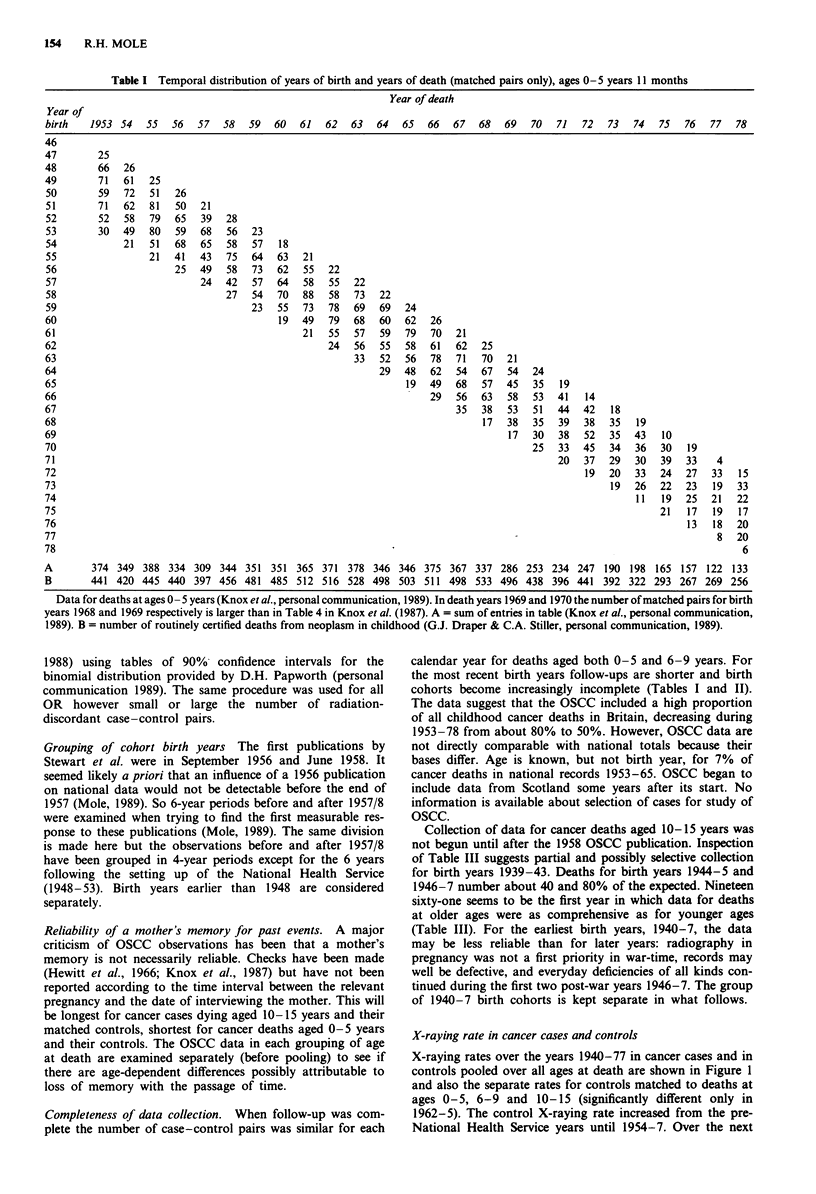







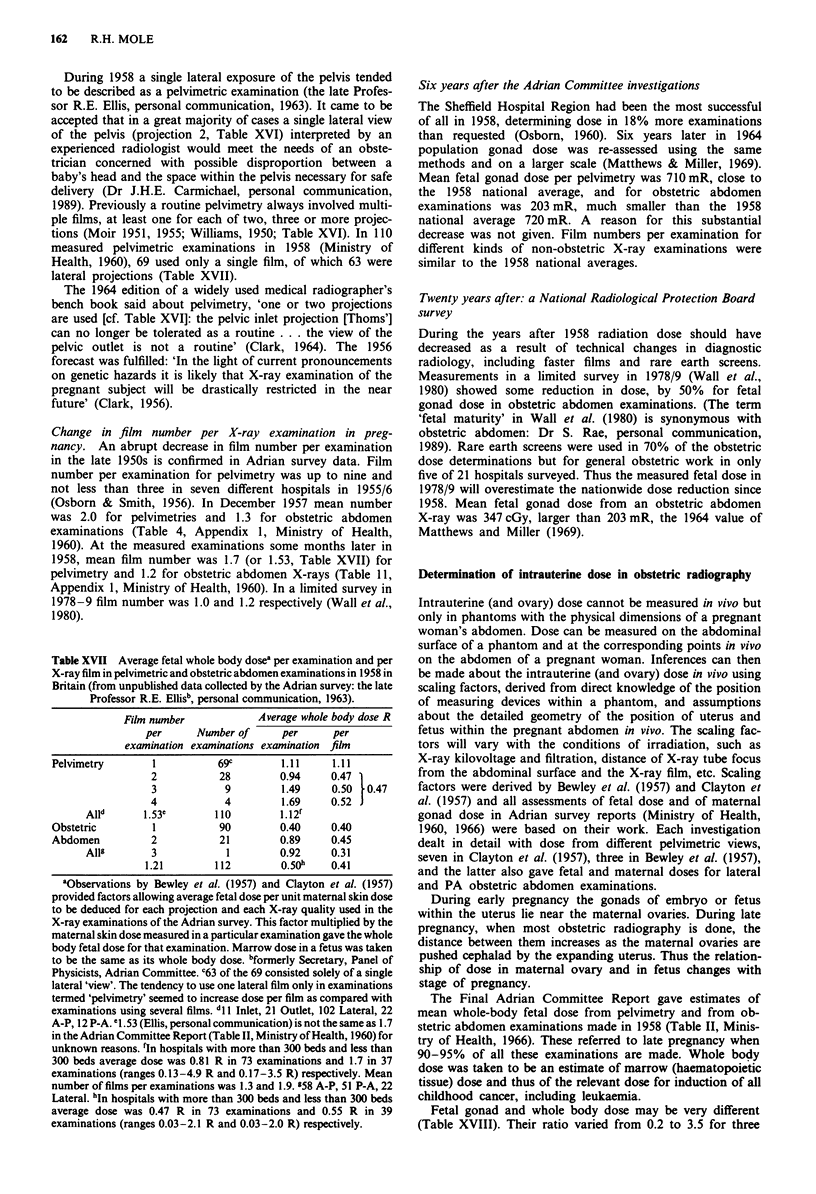

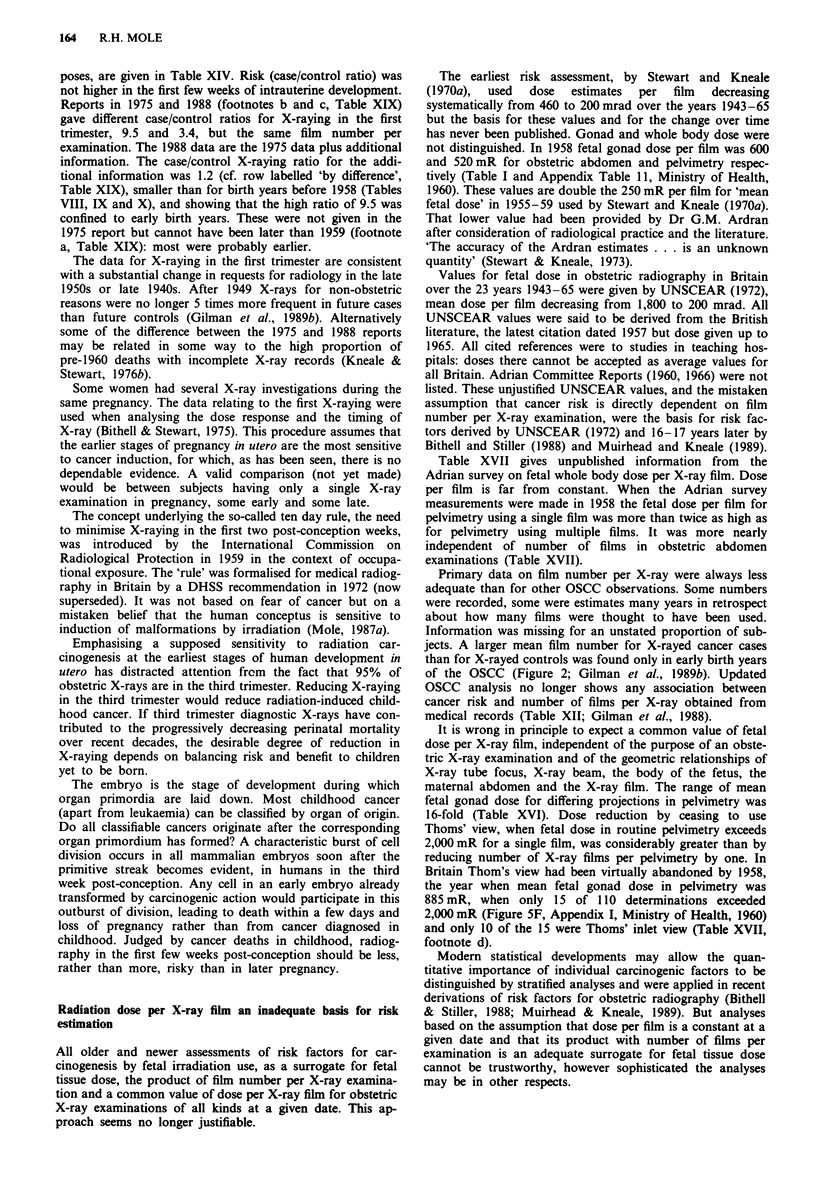
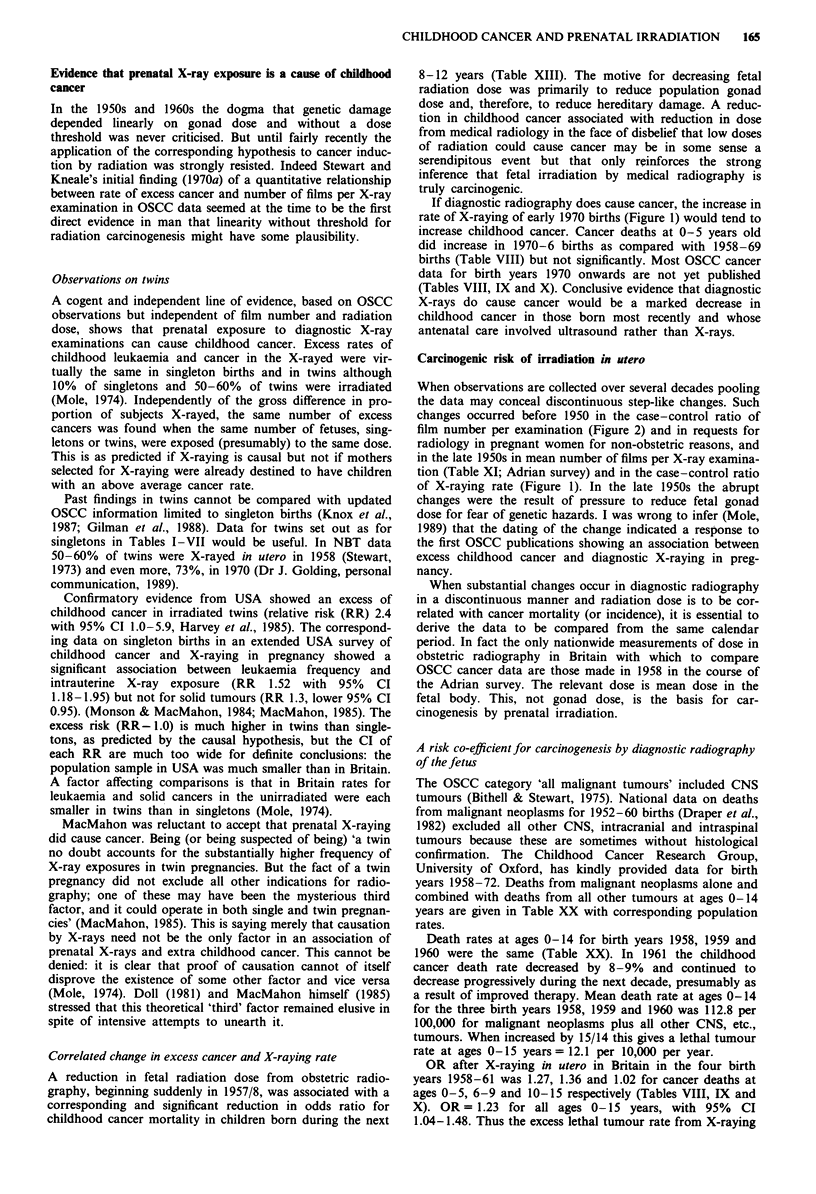
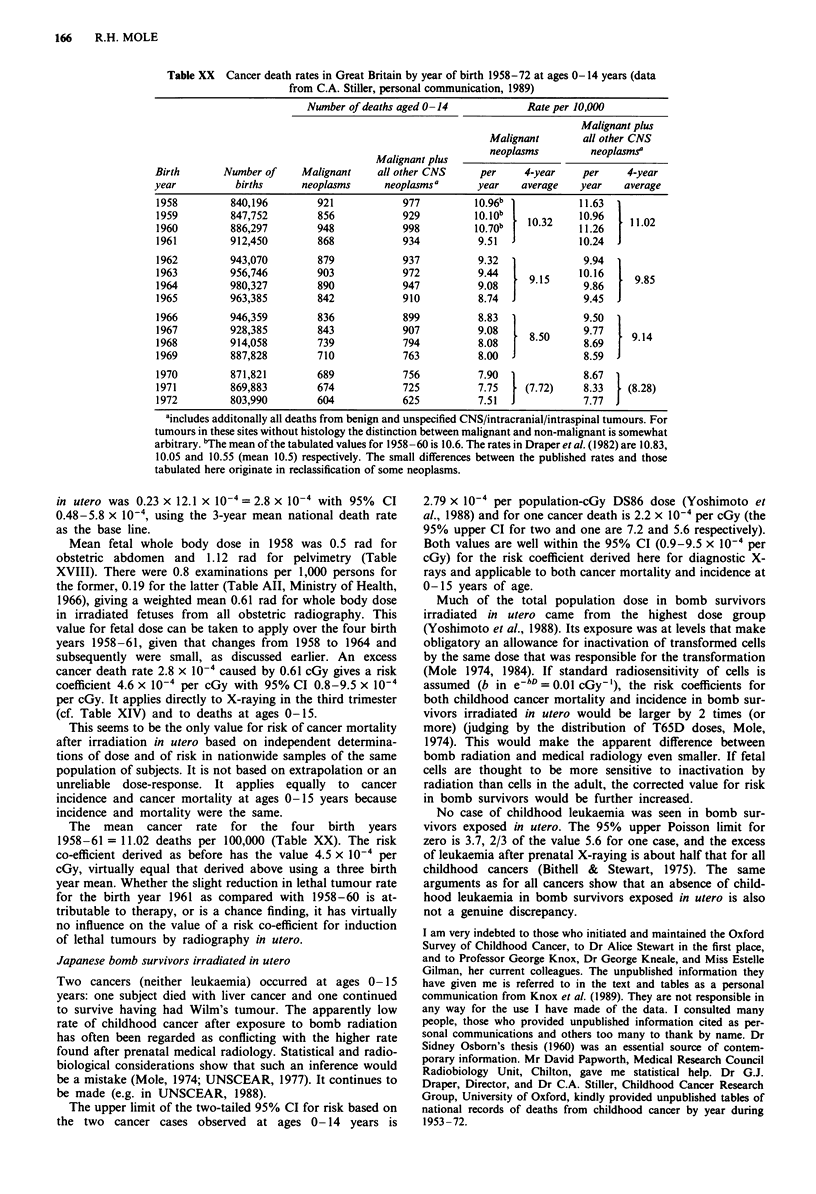


Selected References
These references are in PubMed. This may not be the complete list of references from this article.
- BEWLEY D. K., LAWS J. W., MYDDLETON C. J. Maternal and foetal radiation dosage during obstetric radiographic examinations. Br J Radiol. 1957 Jun;30(354):286–290. doi: 10.1259/0007-1285-30-354-286. [DOI] [PubMed] [Google Scholar]
- Bithell J. F., Stewart A. M. Pre-natal irradiation and childhood malignancy: a review of British data from the Oxford Survey. Br J Cancer. 1975 Mar;31(3):271–287. doi: 10.1038/bjc.1975.62. [DOI] [PMC free article] [PubMed] [Google Scholar]
- Bithell J. F., Stiller C. A. A new calculation of the carcinogenic risk of obstetric X-raying. Stat Med. 1988 Aug;7(8):857–864. doi: 10.1002/sim.4780070804. [DOI] [PubMed] [Google Scholar]
- CLAYTON C. G., FARMER F. T., WARRICK C. K. Radiation doses to the foetal and maternal gonads in obstetric radiography during late pregnancy. Br J Radiol. 1957 Jun;30(354):291–294. doi: 10.1259/0007-1285-30-354-291. [DOI] [PubMed] [Google Scholar]
- Carmichael J. H., Berry R. J. Diagnostic x-rays in late pregnancy and in the neonate. Lancet. 1976 Feb 14;1(7955):351–352. doi: 10.1016/s0140-6736(76)90101-x. [DOI] [PubMed] [Google Scholar]
- Doll R. Radiation hazards: 25 years of collaborative research. Sylvanus Thompson memorial lecture, April 1980. Br J Radiol. 1981 Mar;54(639):179–186. doi: 10.1259/0007-1285-54-639-179. [DOI] [PubMed] [Google Scholar]
- GILES D., HEWITT D., STEWART A., WEBB J. Malignant disease in childhood and diagnostic irradiation in utero. Lancet. 1956 Sep 1;271(6940):447–447. doi: 10.1016/s0140-6736(56)91923-7. [DOI] [PubMed] [Google Scholar]
- Harvey E. B., Boice J. D., Jr, Honeyman M., Flannery J. T. Prenatal x-ray exposure and childhood cancer in twins. N Engl J Med. 1985 Feb 28;312(9):541–545. doi: 10.1056/NEJM198502283120903. [DOI] [PubMed] [Google Scholar]
- Hewitt D., Sanders B., Stewart A. Oxford Survey of Childhood Cancers: progress report. IV. Reliability of data reported by case and control mothers. Mon Bull Minist Health Public Health Lab Serv. 1966 Feb;25:80–85. [PubMed] [Google Scholar]
- Kneale G. W., Stewart A. M. Mantel-Haenszel analysis of Oxford data. I. Independent effects of several birth factors including fetal irradiation. J Natl Cancer Inst. 1976 May;56(5):879–883. doi: 10.1093/jnci/56.5.879. [DOI] [PubMed] [Google Scholar]
- Kneale G. W., Stewart A. M. Mantel-Haenszel analysis of Oxford data. II. Independent effects of fetal irradiation subfactors. J Natl Cancer Inst. 1976 Nov;57(5):1009–1014. doi: 10.1093/jnci/57.5.1009. [DOI] [PubMed] [Google Scholar]
- Kneale G. W., Stewart A. M. Pre-conception X-rays and childhood cancers. Br J Cancer. 1980 Feb;41(2):222–226. doi: 10.1038/bjc.1980.33. [DOI] [PMC free article] [PubMed] [Google Scholar]
- MULLER H. J. The manner of dependence of the permissible dose of radiation on the amount of genetic damage. Acta radiol. 1954 Jan;41(1):5–20. doi: 10.3109/00016925409175829. [DOI] [PubMed] [Google Scholar]
- MacMahon B. Prenatal x-ray exposure and twins. N Engl J Med. 1985 Feb 28;312(9):576–577. doi: 10.1056/NEJM198502283120909. [DOI] [PubMed] [Google Scholar]
- Matthews J. C., Miller H. Radiation hazards from diagnostic radiology. A repeat survey over a small area. Br J Radiol. 1969 Nov;42(503):814–817. doi: 10.1259/0007-1285-42-503-814. [DOI] [PubMed] [Google Scholar]
- Mole R. H. Antenatal irradiation and childhood cancer: causation or coincidence? Br J Cancer. 1974 Sep;30(3):199–208. doi: 10.1038/bjc.1974.182. [DOI] [PMC free article] [PubMed] [Google Scholar]
- Mole R. H. Irradiation of the embryo and fetus. Br J Radiol. 1987 Jan;60(709):17–31. doi: 10.1259/0007-1285-60-709-17. [DOI] [PubMed] [Google Scholar]
- Mole R. H. The so-called 10-day rule. Lancet. 1987 Nov 14;2(8568):1138–1140. doi: 10.1016/s0140-6736(87)91559-5. [DOI] [PubMed] [Google Scholar]
- Morris J. A., Gardner M. J. Calculating confidence intervals for relative risks (odds ratios) and standardised ratios and rates. Br Med J (Clin Res Ed) 1988 May 7;296(6632):1313–1316. doi: 10.1136/bmj.296.6632.1313. [DOI] [PMC free article] [PubMed] [Google Scholar]
- OSBORN S. B., SMITH E. E. The genetically significant radiation dose from the diagnostic use of x-rays in England and Wales; a preliminary survey. Lancet. 1956 Jun 16;270(6929):949–953. doi: 10.1016/s0140-6736(56)91537-9. [DOI] [PubMed] [Google Scholar]
- OSBORN S. B. Variations in the radiation dose received by the patient in diagnostic radiology. Br J Radiol. 1963 Apr;36:230–234. doi: 10.1259/0007-1285-36-424-230. [DOI] [PubMed] [Google Scholar]
- SPIERS F. W. Measurement of the gonadal dose in the medical use of x-rays: a preliminary report on a survey being made in the United Kingdom. Phys Med Biol. 1957 Oct;2(2):152–156. doi: 10.1088/0031-9155/2/2/302. [DOI] [PubMed] [Google Scholar]
- Sankaranarayanan K. Prevalence of genetic and partially genetic diseases in man and the estimation of genetic risks of exposure to ionizing radiation. Am J Hum Genet. 1988 May;42(5):651–662. [PMC free article] [PubMed] [Google Scholar]
- Sinkovics J. G., DiSaia P. J., Rutledge F. N. Tumour immunology and evolution of the placenta. Lancet. 1970 Dec 5;2(7684):1190–1191. doi: 10.1016/s0140-6736(70)90377-6. [DOI] [PubMed] [Google Scholar]
- Stewart A. M. Cancer as a cause of abortions and stillbirths: the effect of these early deaths on the recognition of radiogenic leukaemias. Br J Cancer. 1973 Jun;27(6):465–472. doi: 10.1038/bjc.1973.59. [DOI] [PMC free article] [PubMed] [Google Scholar]
- Stewart A., Kneale G. W. Childhood cancer following obstetric radiography. Health Phys. 1973 Mar;24(3):359–359. [PubMed] [Google Scholar]
- Stewart A., Kneale G. W. Radiation dose effects in relation to obstetric x-rays and childhood cancers. Lancet. 1970 Jun 6;1(7658):1185–1188. doi: 10.1016/s0140-6736(70)91782-4. [DOI] [PubMed] [Google Scholar]
- Stewart A. Low dose radiation cancers in man. Adv Cancer Res. 1971;14:359–390. doi: 10.1016/s0065-230x(08)60524-2. [DOI] [PubMed] [Google Scholar]
- Yoshimoto Y., Kato H., Schull W. J. Risk of cancer among children exposed in utero to A-bomb radiations, 1950-84. Lancet. 1988 Sep 17;2(8612):665–669. doi: 10.1016/s0140-6736(88)90477-1. [DOI] [PubMed] [Google Scholar]


